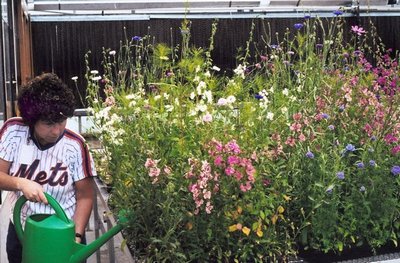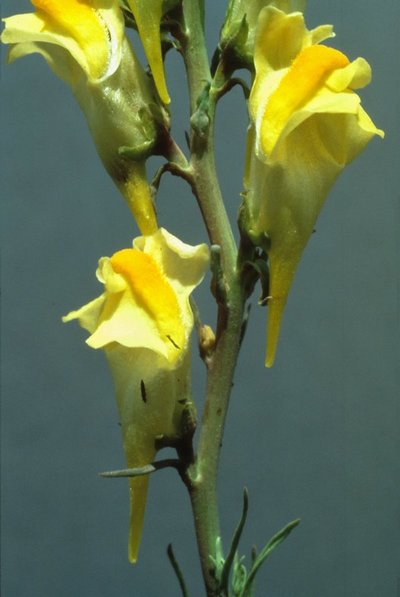April 18, 2002
Wildflower seed mixes include some wicked bloomers
The seed packets have labels with romantic-sounding names such as meadow mixture and wedding wildflowers, while others tout backyard biodiversity and make reference to Earth Day. When growing 19 such packets of wildflower mixes, however, University of Washington researchers found that each contained from three to 13 invasive species and eight had seeds for plants considered noxious weeds in at least one U.S. state or Canadian province.
And what makes it nearly impossible for gardeners who want to be conscientious is that a third of the packets listed no contents and a little more than another third had inaccurate lists. Only five of the 19 correctly itemized everything.
“I can’t recommend using any wildflower seed mixes,” says Lorraine Brooks, who did the work at the UW’s Center for Urban Horticulture while earning her bachelor’s degree.
The seed mixes in this experiment were produced at or distributed from a variety of U.S. and Canadian locations, not just the Pacific Northwest. Firms with catalog or Web site sales could be selling wildflower mixes to gardeners all across North America and not just to gardeners in the area where the mix is produced.
Brooks found the least unruly of the wildflower mixes was a packet from which only 30 of the 106 plants that sprouted and produced flowers were invasive — that’s 28 percent of what grew. From another packet all the species identified were invasive in at least one part of the country and, although the three species in the packet labeled “native” are native to North America, it doesn’t mean they are native to all regions. For example, only one species is believed to be native to the Pacific Northwest and it represented 1 percent of what grew. Among the worst mixes were two that each contained two noxious weed species.
Brooks and Sarah Reichard, UW assistant professor of forest resources, say gardeners are better off using their favorite plants, or seeds for their favorites, in order to control what’s grown in their yards.
In Washington, the state and 49 local weed control boards maintain lists of invasive species and noxious weeds. Depending on how serious a threat is posed by a species and how widespread it already is, weed managers may prohibit its sale and demand landowners eliminate it. Other species fall into categories in which landowners must prevent the plant from going to seed, for instance by deadheading spent blossoms, to prevent it from spreading.
Gardeners might be surprised at the flowers and seeds that are readily available for sale that are considered invasive or noxious. For instance, the wildflower most commonly observed as part of the mixes was the popular bachelor’s button (Centaurea cyanus), germinating in beautiful hues of pink and blue from three-quarters of the packets tested. Bachelor’s button might be fine if kept confined to one’s own yard but it’s invasive — that is it outcompetes other plants — when it gets into native grasslands and prairies.
It hasn’t been named a noxious weed but it is on the state’s “education list” in the hope that property owners will become knowledgeable about the risks of growing it, says Reichard, who serves on the committee that considers changes proposed for the state’s list.
Yellow toadflax (Linaria vulgaris) on the other hand is listed as a noxious weed in Washington, Oregon, Idaho and 11 other states and provinces. Colorado, for example, classifies it among the top-10 prioritized noxious-weed species, those that are most widespread and cause the greatest impact. In King County the plant is a “principal weed for control,” an even stronger designation than Washington state’s listing of it as a Class C noxious weed.
With yellow flowers tinged with orange that resemble snapdragon blossoms, toadflax was found in four of the wildflower mixes. One listed it.
Even labels that refer to wildflowers as native should be avoided because everything is native to someplace, but that place may not be where you live, Reichard says. Just think about the differences in plants between Eastern and Western Washington, she says.
The 19 packets tested were distributed by firms including Burpee, Ed Hume, Lake Valley Seed, Lilly Miller, Molbak’s, Napa Valley Wildflower, Nature’s Garden Seed and Sundance. Seventeen of the mixes in the experiment were purchased and two were gift items.
There are, of course, many other firms that distribute wildflower seed mixes not tested as part of this experiment. Handed out as favors or fund raising thank-yous by environmental and charitable groups, and bearing labels that refer to pastures, meadows and native flowers, these mixes may even make people think they are suitable for areas next to woodlands, fields or prairies, Brooks says.
“But that would be a big mistake.”
Noxious weeds and invasives that grew
UW researchers identified 84 species when growing 19 packets of wildflower seeds from across the nation.
The four listed as noxious weeds in at least one state or Canadian province were common yarrow, Achillea millefolium; dame’s rocket, Hesperis matronalis; redroot pigweed, Amaranthus retroflexus; and yellow toadflax, Linaria vulgaris. Noxious weeds fall under the control of various national, state and local agencies.
Thirty-six other species that grew are considered invasive in one or more region of North America. If invasives are not on noxious weed lists where a consumer lives, then it is up to individual gardeners to weigh the responsibility of using such plants.
As the U.S. Department of Agriculture says about the list of invasives it maintains, “These plants are invasive or have a high potential to become invasive in all or part of their U.S. range. Most are introduced to the United States, but some are harmful pests in parts of this country, and valuable natives in others.” As for plants with invasive tendencies that are used outside their range, UW’s Reichard says, “Repeated studies have show that species that are invasive elsewhere tend to be invasive when introduced to new areas.”
The list of noxious and invasive species that grew during the UW experiment was compiled using lists for various parts of the country as there is no single, national list of invasives.
Key questions raised by this study
- The mixes in this experiment were produced at or distributed from a variety of U.S. and Canadian locations, not just the Pacific Northwest. Firms with catalog or Web site sales could be selling wildflower mixes to gardeners all across North America and not just to gardeners in the area where the mix is produced. Key questions to be considered by consumers and all seed companies, not just the ones in the study:
- Should a consumer buy wildflower seed mixes that don’t list their contents?
- Should a consumer expect that what’s listed on a wildflower seed mix will be what actually grows?
- How can consumers know that wildflower seed mixtures shouldn’t be spread near or in natural woodlands, meadows or fields when they are labeled with words such as “native,” “biodiversity” and the term “wildflower” itself?
- Should wildflower mixes be regionalized so the mixes are free of plants considered noxious weeds where a consumer lives?
- Should wildflower mixes be regionalized so the mixes are free of what are considered invasive species where a consumer lives?
- Should any consideration be given before species that have proven invasive in one part of the country are included in mixes sold in other parts of the country?
Web sites for more information:
- On Washington State’s Noxious Weed Control Board Web site read “Meadow in a Can: Does it Really Work?” at http://www.wa.gov/agr/weedboard/education/meadow.html
- Nature Conservancy’s Wildland Invasive Species Team explains what happens when invasives get into wildlands at http://tncweeds.ucdavis.edu/common.html
- For some listed invasive species go to the “Invasive & Noxious” section of http://plants.usda.gov/cgi_bin/topics.cgi?earl+noxious.cgi
- Find state noxious weed sites and lists at http://www.ars-grin.gov/npgs/tax/taxweed.html
For more information:
- Brooks has completed her degree. Contact Sandra Hines, shines@u.washington.edu, 206-543-2580 for help reaching her.
- Reichard, 206-616-5020, reichard@u.washington.edu
For an opinion on wildflower seed mixes from the American Seed Trade Association, contact chief executive officer Richard Crowder at 703-837-8140.
Recent news coverage of this research includes stories in The Seattle Times of May 5 and The (Portland) Oregonian of May 9.
Images for use by news media only, on the Web at:
http://www.washington.edu/newsroom/news/images/flowers2.jpg
Lorraine Brooks waters flats filled with wildflowers grown in the Center for Urban Horticulture greenhouse. Photo credit: Philip Brooks
http://www.washington.edu/newsroom/news/images/toadflax.jpg
Blossoms of yellow toadflax resemble snapdragon flowers.
Photo credit: King County Department of Natural Resources
###


